介绍
行为与std::vector类似,但是使用了small buffer optimization(类似于fbstring中的SSO),将指定个数的数据内联在对象中,而不是像std::vector直接将对象分配在堆上,避免了malloc/free的开销。
small_vector基本兼容std::vector的接口。
small_vector<int,2> vec;
vec.push_back(0); // Stored in-place on stack
vec.push_back(1); // Still on the stack
vec.push_back(2); // Switches to heap buffer.small_vector<int,2> vec指定可以内联在对象中2个数据:
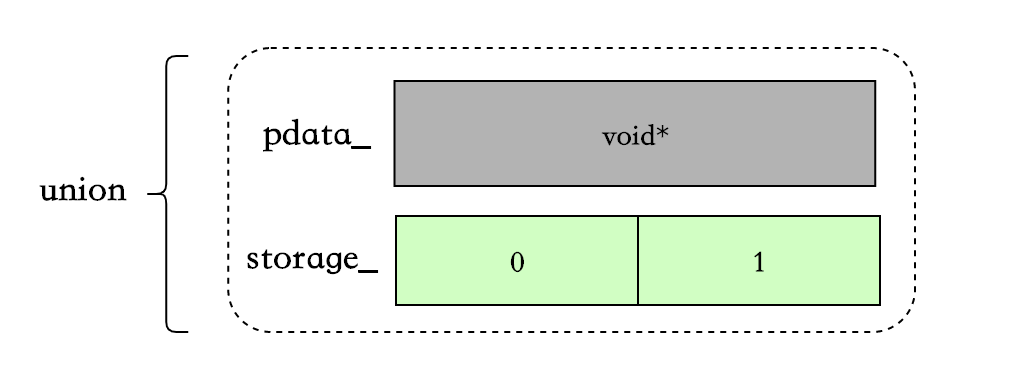
当超过2个后,后续添加的数据会被分配到堆上,之前的2个数据也会被一起move到堆上:
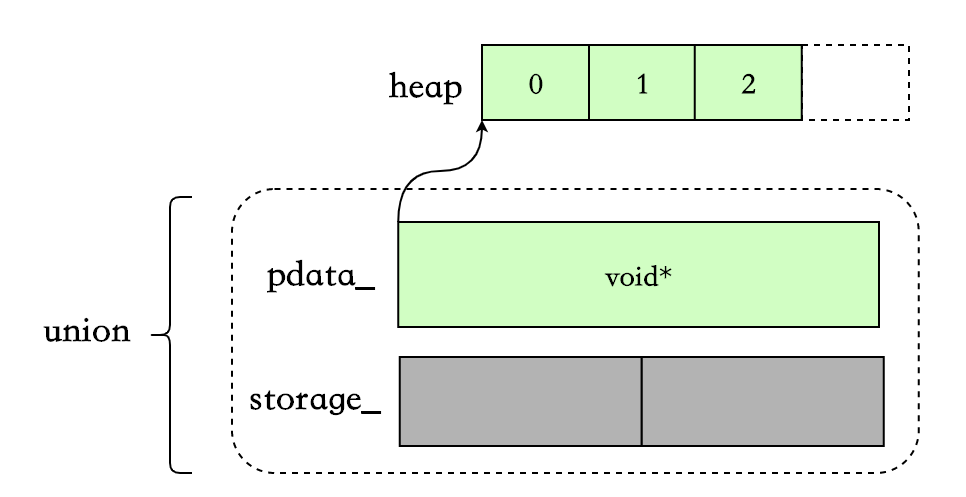
使用场景
根据官方文档的介绍,small_vector在下面3种场景中很有用:
- 需要使用的vector的生命周期很短(比如在函数中使用),并且存放的数据占用空间较小,那么此时节省一次malloc是值得的。
- 如果vector大小固定且需要频繁查询,那么在绝大多数情况下会减少一次cpu cache miss,因为数据是内联在对象中的。
- 如果需要创建上亿个vector,而且不想在记录capacity上浪费对象空间(一般的vector对象内会有三个字段:pointer _Myfirst、pointer _Mylast、pointer _Myend)。small_vector允许让malloc来追踪
allocation capacity(这会显著的降低insertion/reallocation效率,如果对这两个操作的效率比较在意,你应该使用FBVector,FBVector在官方描述中可以完全代替std::vector)
比如在io/async/AsyncSocket.h中,根据条件的不同使用small_vector或者std::vector:
// Lifecycle observers.
//
// Use small_vector to avoid heap allocation for up to two observers, unless
// mobile, in which case we fallback to std::vector to prioritize code size.
using LifecycleObserverVecImpl = conditional_t<
!kIsMobile,
folly::small_vector<AsyncTransport::LifecycleObserver*, 2>,
std::vector<AsyncTransport::LifecycleObserver*>>;
LifecycleObserverVecImpl lifecycleObservers_;
// push_back
void AsyncSocket::addLifecycleObserver(
AsyncTransport::LifecycleObserver* observer) {
lifecycleObservers_.push_back(observer);
}
// for loop
for (const auto& cb : lifecycleObservers_) {
cb->connect(this);
}
// iterator / erase
const auto eraseIt = std::remove(
lifecycleObservers_.begin(), lifecycleObservers_.end(), observer);
if (eraseIt == lifecycleObservers_.end()) {
return false;
}为什么不是std::array
下面两种情况,small_vector比std::array更合适:
- 需要空间后续动态增长,不仅仅是编译期的固定size。
- 像上面的例子,根据不同条件使用std::vector/small_vector,且使用的API接口是统一的。
其他用法
NoHeap: 当vector中数据个数超过指定个数时,不会再使用堆。如果个数超过指定个数,会抛出std::length_error异常。<Any integral type>: 指定small_vector中size和capacity的数据类型。
// With space for 32 in situ unique pointers, and only using a 4-byte size_type.
small_vector<std::unique_ptr<int>, 32, uint32_t> v;
// A inline vector of up to 256 ints which will not use the heap.
small_vector<int, 256, NoHeap> v;
// Same as the above, but making the size_type smaller too.
small_vector<int, 256, NoHeap, uint16_t> v;其中,依赖boost::mpl元编程库,可以让后两个模板变量任意排序。
其他类似库
Benchmark
没有找到官方的benchmark,自己简单的写了一个,不测试数据溢出到堆上的情况。
插入4个int,std::vector使用reserve(4)预留空间。
BENCHMARK(stdVector, n) {
FOR_EACH_RANGE(i, 0, n) {
std::vector<int> vec;
vec.reserve(4);
for (int i = 0; i < 4; i++) {
vec.push_back(1);
}
doNotOptimizeAway(vec);
}
}
BENCHMARK_DRAW_LINE();
BENCHMARK_RELATIVE(smallVector, n) {
FOR_EACH_RANGE(i, 0, n) {
small_vector<int, 4> vec;
for (int i = 0; i < 4; i++) {
vec.push_back(1);
}
doNotOptimizeAway(vec);
}
}结果是:small_vector比std::vector快了40%:
============================================================================
delve_folly/benchmark.cc relative time/iter iters/s
============================================================================
stdVector 440.79ns 2.27M
----------------------------------------------------------------------------
smallVector 140.48% 313.77ns 3.19M
============================================================================如果把stdVector中的vec.reserve(4);去掉,那么small_vector速度比std::vector快了3倍。在我的环境上,std::vector的扩容因子为2,如果不加reserve,那么std::vector会有2次扩容的过程(貌似很多人不习惯加reserve,是有什么特别的原因吗 : )):
============================================================================
delve_folly/benchmark.cc relative time/iter iters/s
============================================================================
stdVector 1.26us 795.06K
----------------------------------------------------------------------------
smallVector 417.25% 301.44ns 3.32M
============================================================================代码关注点
small_vector代码比较少,大概1300多行。主要关注以下几个方面:
- 主要类。
- 数据存储结构,capacity的存储会复杂一些。
- 扩容过程,包括数据从对象中迁移到堆上。
- 常用的函数,例如push_back、reserve、resize。
- 使用makeGuard代替了原版的try-catch。
- 通过boost::mpl支持模板参数任意排序。
- 通过boost-operators简化operator以及C++20的<=>。
主要类
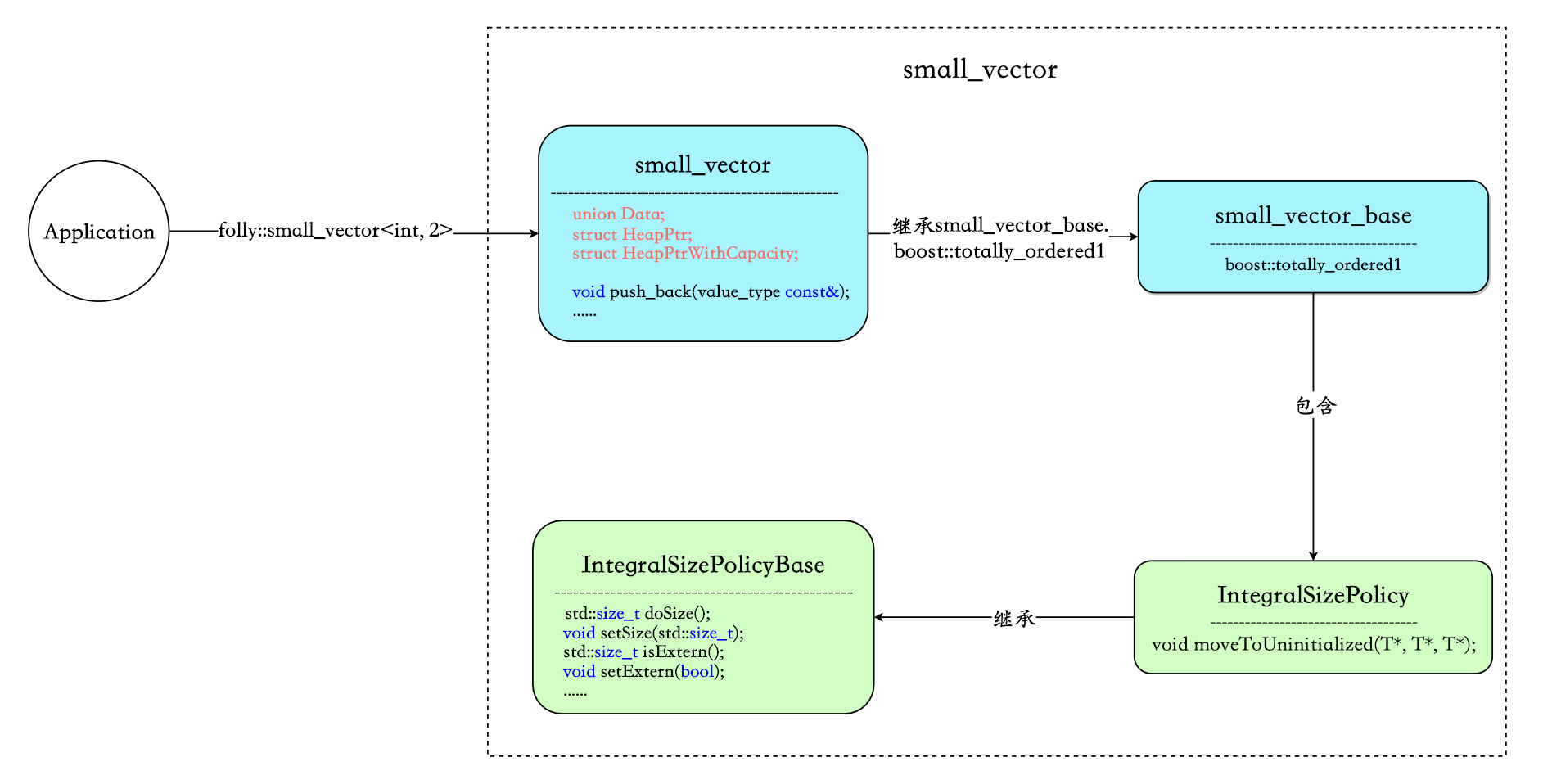
- small_vector : 包含的核心字段为
union Data、struct HeapPtr、struct HeapPtrWithCapacity,这三个字段负责数据的存储。此外small_vector对外暴露API接口,例如push_back、reserve、resize等。 - small_vector_base : 没有对外提供任何函数接口,类内做的就是配合boost::mpl元编程库在编译期解析模板参数,同时生成boost::totally_ordered1供small_vector继承,精简operator代码。
- IntegralSizePolicyBase:负责size/extern/heapifiedCapacity相关的操作。
- IntegralSizePolicy : 负责内联数据溢出到堆的过程。
small_vector
声明:
template <
class Value,
std::size_t RequestedMaxInline = 1,
class PolicyA = void,
class PolicyB = void,
class PolicyC = void>
class small_vector : public detail::small_vector_base<
Value,
RequestedMaxInline,
PolicyA,
PolicyB,
PolicyC>::type 声明中有三个策略模板参数是因为在一次提交中删除了一个无用的策略,OneBitMutex:Delete small_vector's OneBitMutex policy。
small_vector_base
template <
class Value,
std::size_t RequestedMaxInline,
class InPolicyA,
class InPolicyB,
class InPolicyC>
struct small_vector_base;boost::mpl放到最后说吧 :)
数据结构
small_vector花了一些心思在capacity的设计上,尽可能减小对象内存,降低内联数据带来的影响。
union Data负责存储数据:
union Data{
PointerType pdata_; // 溢出到堆后的数据
InlineStorageType storage_; // 内联数据
}u;InlineStorageType
使用std::aligned_storage进行初始化,占用空间是sizeof(value_type) * MaxInline,对齐要求为alignof(value_type):
typedef typename std::aligned_storage<sizeof(value_type) * MaxInline, alignof(value_type)>::type InlineStorageType;capacity
与std::vector用结构体字段表示capacity不同,small_vector的capacity存放分为三种情况。
capacity内联在对象中
这是最简单的一种情况:
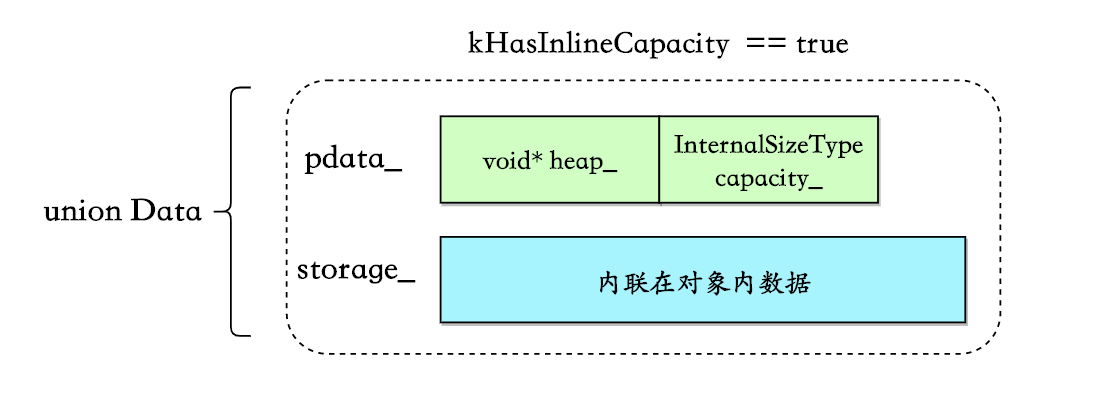
条件为sizeof(HeapPtrWithCapacity) < sizeof(InlineStorageType) (这里我不明白为什么等于的情况不算在内):
static bool constexpr kHasInlineCapacity = sizeof(HeapPtrWithCapacity) < sizeof(InlineStorageType);
typedef typename std::conditional<kHasInlineCapacity, HeapPtrWithCapacity, HeapPtr>::type PointerType;
struct HeapPtrWithCapacity {
value_type* heap_;
InternalSizeType capacity_;
} ;
union Data{
PointerType pdata_; // 溢出到堆后的数据
InlineStorageType storage_; // 内联数据
}u;通过malloc_usable_size获取capacity
假如上述kHasInlineCapacity == false,即sizeof(InlineStorageType) <= sizeof(HeapPtrWithCapacity)时,考虑到节省对象空间,capacity不会内联在对象中,此时PointerType的类型为HeapPtr,内部只保留一个指针:
struct HeapPtr {
value_type* heap_;
} ;
union Data{
PointerType pdata_; // 溢出到堆后的数据
InlineStorageType storage_; // 内联数据
}u;那么此时capacity存放在哪里了呢?这里又分了两种情况,第一种就是这里要说明的:直接通过malloc_usable_size获取从堆上分配的内存区域的可用数据大小,这个结果就被当做small_vector当前的capacity:
malloc_usable_size(heap_) / sizeof(value_type); // heap_指向堆上的数据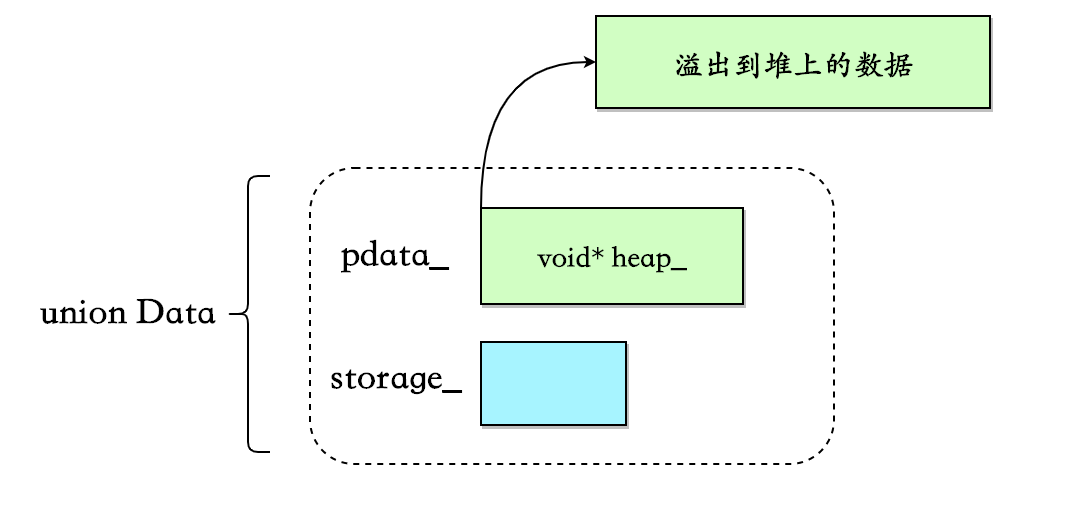
但是有一个问题,由于内存分配存在alignment和minimum size constraints的情况,malloc_usable_size返回的大小可能会大于申请时指定的大小,但是folly会利用这部分多余的空间来存放数据(如果能放的下)。
比如在不使用jemalloc的情况下,在扩容的函数内,将向系统申请的字节数、malloc_usable_size返回的可用空间、small_vector的capacity打印出来:
folly::small_vector<uint32_t, 2> vec; // uint32_t => four bytes
for (int i = 0; i < 200; i++) {
vec.push_back(1);
std::cout << vec.capacity() << std::endl;
}
// 代码进行了简化
template <typename EmplaceFunc>
void makeSizeInternal(size_type newSize, bool insert, EmplaceFunc&& emplaceFunc, size_type pos) {
const auto needBytes = newSize * sizeof(value_type);
const size_t goodAllocationSizeBytes = goodMallocSize(needBytes);
const size_t newCapacity = goodAllocationSizeBytes / sizeof(value_type);
const size_t sizeBytes = newCapacity * sizeof(value_type);
void* newh = checkedMalloc(sizeBytes);
std::cout << "sizeBytes:" << sizeBytes << " malloc_usable_size:" << malloc_usable_size(newh) << " "
<< kMustTrackHeapifiedCapacity << std::endl;
// move元素等操作,略过....
}
// output :
2
2
sizeBytes:16 malloc_usable_size:24 0
6
6
6
6
sizeBytes:40 malloc_usable_size:40 0
10
10
10
10
sizeBytes:64 malloc_usable_size:72 0
18
18
18
18
18
18
18
18
......
......可以看出,扩容时即使向系统申请16字节的空间,malloc_usable_size返回的是24字节,而small_vector此时的capacity也是24,即会利用多余的8个字节额外写入2个数据。
**如果使用了jemalloc **,那么会根据size classes分配空间。
这种方式也是有使用条件的,即needbytes >= kHeapifyCapacityThreshold,kHeapifyCapacityThreshold的定义为:
// This value should we multiple of word size.
static size_t constexpr kHeapifyCapacitySize = sizeof(typename std::aligned_storage<sizeof(InternalSizeType), alignof(value_type)>::type);
// Threshold to control capacity heapifying.
static size_t constexpr kHeapifyCapacityThreshold = 100 * kHeapifyCapacitySize;我没想明白这个100是怎么定下来的
标签:std,capacity,folly,vector,small,type,size From: https://www.cnblogs.com/arthurzyc/p/16895619.html